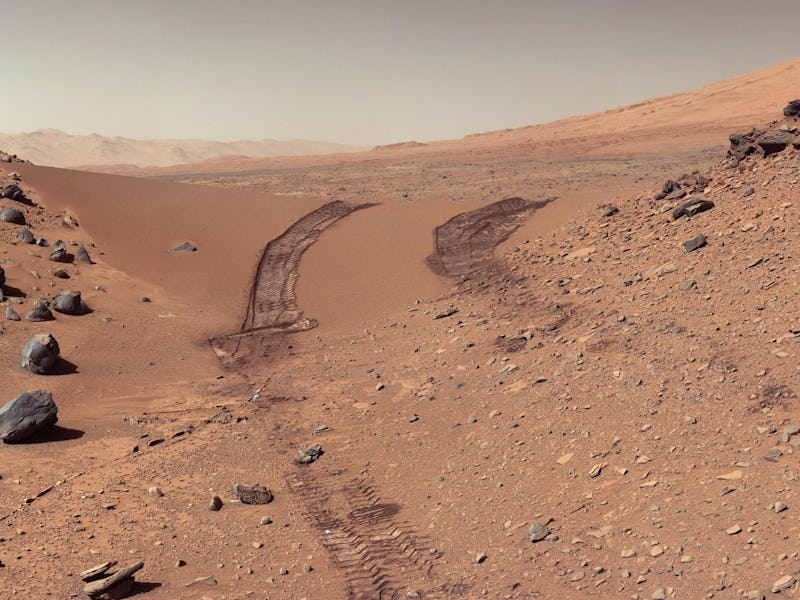Turns Out Mars Was Always a Cold Wasteland
Gone are the hopes that Mars was once a wet, tropical world.

Earlier this month, NASA revealed findings that strongly support the notion that solar winds had stripped Mars of its atmosphere over billions of years.
Without a robust atmosphere that could provide stable surface pressures and temperatures, all of the vast oceans and lakes that once covered the surface of the planet began to vanish. A warm planet that once boasted huge bodies of water quickly turned into a cold, dry wasteland.
Or so that’s what we thought. New research published Tuesday by scientists at the California Institute of Technology and NASA’s Jet Propulsion Laboratory suggests Mars never actually had a dense atmosphere — only a moderate one that created just a fraction of the surface pressure found on Earth. Gone are the hopes that Mars was once a wet, tropical world with the potential to host many kinds of complex life forms. Instead, it was largely the same as it ever was.
“The jury is still out on how extensive an ocean there may have been, if it ever existed,” says Bethany Ehlmann, a planetary scientist at Caltech and the JPL and a coauthor of the new study. “But the new data clarifies for climate modelers, who have to explain why these lakes could persist, what the plausible atmospheric conditions are. It’s a slight adjustment in our thinking of what early Mars might have looked like.” Ehlmann thinks environments like the southwest deserts of North America or the polar deserts of Antarctica — which still do contain standing bodies of water — act as better paradigms for what Mars might have looked like in the past.
Right now, scientists believe that any planetary atmosphere that’s capable of hosting liquid water probably needs a thick atmosphere consisting of enough carbon dioxide — a useful greenhouse gas — to trap enough heat and engender a surface pressure that keeps the water there. Ehlmann thinks Mars probably had an atmosphere that was basically just thick enough to keep the liquid water on the surface from immediately evaporating or subliming away, but that the atmosphere didn’t contain nearly enough greenhouse carbon dioxide as we previously thought.
An artist's impression of what an ancient, wet Mars might have looked like. New data makes this possibility extremely unlikely.
Thus, the mystery of where all that carbon fled to as the atmosphere was stripped away is actually much ado about nothing — those carbon reservoirs don’t exist, because it was never really on the planet in the first place. Call off the search; time to pack it up and go home, people.
Okay, maybe not so fast. Behlmann emphasizes that the new paper “is fundamentally a modeling study.” It’s built from data collected from a whole litany of instruments and missions, including ground-based work involving isotope analysis of carbonate in meteorites, remote sensing operations of rocks on Mars, and most recently information gathered by the Sample Analysis at Mars instrument on the Curiosity rover, capable of conducting some basic onboard chemical analysis of rock samples.
Basically, the research team plugged in all of this data into computer models that show that the current geological state of Mars is only best explained if the atmosphere used to be at moderate levels, in which carbon compounds in the air dwindled away slowly rather than being sharply shaved off.
This would help explain why carbon deposits in the Martian atmosphere are lower than expected.
The findings still need to be confirmed before we start making any definitive conclusions. “The best thing, ideally, would be to get on the ground and measure the actual isotope value of carbonate,” says Ehlmann.
Of course, this is much easier said than done. Obviously we’re a long ways away from sending humans to do that job themselves. And while the Mars 2020 rover will be capable of collecting samples that can be sent back to Earth, that mission doesn’t launch for another five years.
A network of prominent mineral veins below a cap rock ridge on lower Mount Sharp on the surface of Mars.
Another key to verifying the results might be the MAVEN space probe, which was critical in helping NASA scientists determine how Mars lost its atmosphere in the first place.
MAVEN’s data also correlated well with the atmospheric loss rates Ehlmann and her team also calculated: “As MAVEN continues to make measurements over the next year, it’s going to be really important to pin down more details on the loss rates of the carbon and oxygen species. MAVEN has the ability to constrain those.” she says.
Moving forward, Ehlmann hopes the new paper will help highlight the importance of studying isotopes in future geological and atmospheric research of Mars, as well as how useful it is to couple different sources of data together to make conjectures about planetary science.
“It’s the key to really nailing the question of the evolution of habitable environments on Earth versus Mars,” says Ehlmann.
Although the results are a setback for those hoping to find evidence of past or current life on Mars, they don’t disprove anything yet. Lots of organisms on Earth are able of withstanding extreme conditions. There’s no reason to think Martian life couldn’t do the same.